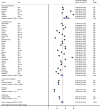Medical injection and access to sterile injection equipment in low- and middle-income countries: a meta-analysis of Demographic and Health Surveys (2010-2017)
- PMID: 31851322
- PMCID: PMC7443715
- DOI: 10.1093/inthealth/ihz113
Medical injection and access to sterile injection equipment in low- and middle-income countries: a meta-analysis of Demographic and Health Surveys (2010-2017)
Abstract
Background: Unsafe injection practices contribute to increased risks of blood-borne infections, including human immunodeficiency virus, hepatitis B and hepatitis C viruses. The aim of this study was to estimate the prevalence of medical injections as well as assess the level of access to sterile injection equipment by demographic factors in low- and middle-income countries (LMICs).
Methods: We carried out a meta-analysis of nationally representative Demographic and Health Surveys (DHSs) conducted between 2010 and 2017 in 39 LMICs. Random effects meta-analysis was used in estimating pooled and disaggregated prevalence. All analyses were conducted using Stata version 14 and Microsoft Excel 2016.
Results: The pooled 12-month prevalence estimate of medical injection was 32.4% (95% confidence interval 29.3-35.6). Pakistan, Rwanda and Myanmar had the highest prevalence of medical injection: 59.1%, 56.4% and 53.0%, respectively. Regionally, the prevalence of medical injection ranged from 13.5% in west Asia to 42.7% in south and southeast Asia. The pooled prevalence of access to sterile injection equipment was 96.5%, with Pakistan, Comoros and Afghanistan having comparatively less prevalence: 86.0%, 90.3% and 90.9%, respectively.
Conclusions: Overuse of medical injection and potentially unsafe injection practices remain a considerable challenge in LMICs. To stem the tides of these challenges, national governments of LMICs need to initiate appropriate interventions, including education of stakeholders, and equity in access to quality healthcare services.
Keywords: blood-borne infections; low- and middle-income countries; medical injection; sterile injection equipment.
© The Author(s) 2019. Published by Oxford University Press on behalf of Royal Society of Tropical Medicine and Hygiene.
Figures
References
-
- World Health Organization WHO guideline on the use of safety-engineered syringes for intramuscular, intradermal and subcutaneous injections in health care settings. Geneva: World Health Organization, 2016. - PubMed
-
- World Health Organization Global hepatitis report 2017. Geneva: World Health Organization, 2017.
-
- Gore C, Lazarus J, Peck R, et al. . Unnecessary injecting of medicines is still a major public health challenge globally. Trop Med Int Health. 2013;18(9):1157–1159. - PubMed
-
- Altaf A, Janjua NZ, Hutin Y. The cost of unsafe injections in Pakistan and challenges for prevention program. J Coll Physicians Surg Pak. 2006;16(9):622–624. - PubMed
Publication types
MeSH terms
LinkOut - more resources
Full Text Sources



